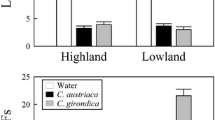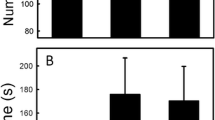Abstract
Siberian chipmunks were presented with snakes and 4 control animals (tortoises, frogs, eels, quails) in a large outdoor pen to examine whether the snakedirected behavior of the chipmunk is a response to identifying the snake or simply an exploratory behavior toward generally strange objects. The animals were presented to chipmunks in 3 manners; tethered, anesthetized, and in perforated opaque boxes and in wire netting boxes. In “tethered” and “anesthetized”, chipmunks responded significantly more intensively to snakes than to other animals. When the animals were presented in the boxes, that is, when chipmunks could perceive only olfactory stimulus from the animals, they also showed the strongest response to snakes. The results suggest that 1) snake-directed behavior of chipmunks is not a general exploratory response toward strange objects but a response to identifying the snakes, and that 2) olfaction is an important cue for the chipmunks to identify snakes.
Similar content being viewed by others
References
Altmann, S. A. 1956 Avian mobbing behavior and predator recognition.Condor 58: 241–253.
Brand, L. R. 1976 The vocal repertorie of chipmunks (genusEutamias) in California.Anim. Behav. 24: 319–335.
Coss, R. G. & D. H. Owings 1978 Snake-directed behavior by snake naive and experienced ground squirrels.Z. Tierpsychol. 48: 421–435.
Curio, E. 1975 The functional organization of anti-predator behaviour in the pied flycatcher A study of avian visual perception.Anim. Behav. 23: 1–115.
Harvey, P. H. & P. J. Greenwood 1978 Antipredator defense strategies: some evolutionary problems. In: J. R. Krebs & N. B. Davies (eds.)Behavioural ecology-an evolutionary approach. pp. 129–511. Blackwell Scientific Publications.
Hennessy, D. F. & D. H. Owings 1980 Snake species discrimination and the role of olfactory cues in the snake-directed behavior of the California ground squirrel.Behaviour 65: 115–123.
Kawamichi, M. 1978 Life of chipmunks.Shiretoko shiryokan hokohu 5: 1–7 (in Japanese)
Kobayashi, T. & M. Watanabe 1981 Snake-scent application behavior in the Siberian chipmunkEutamias sibiricus asiaticus.Proc. Japan Acad. 57 B: 141–145.
Kobayashi, T. & M. Watanabe 1986 An analysis of snake-scent application behaviour in Siberian chipmunks (Eutamias sibiricus asiaticus).Ethology 72: 40–52.
Kruuk, H. 1964 Predators and anti-predator behaviour of the black-headed gull (Larus ridibundus).Behaviour Suppl. 2. 129 pp.
Owings, D. H. & R. G. Coss 1977 Snake mobbing by California ground squirrels: adaptive variation and ontogeny.Behaviour 62: 50–69.
Owings, D. H. & S. C. Owings 1979 Snake-directed behavior by black-tailed prarie dogs (Cynomys ludovicianus).Z. Tierpsychol. 49: 35–54.
Rowe, M. P. & D. H. Owings 1978 The meaning of the sound of rattling by rattlesnakes to California ground squirrels.Behaviour. 66: 252–267.
Author information
Authors and Affiliations
About this article
Cite this article
Kobayashi, T. Does the Siberian chipmunk respond to the snake by identifying it?. J. Ethol. 5, 137–144 (1987). https://doi.org/10.1007/BF02349946
Received:
Accepted:
Issue Date:
DOI: https://doi.org/10.1007/BF02349946




